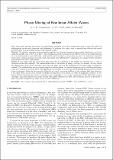Files in this item
Phase mixing of nonlinear Alfvén waves
Item metadata
| dc.contributor.author | Prokopyszyn, A. P. K. | |
| dc.contributor.author | Hood, A. W. | |
| dc.contributor.author | De Moortel, I. | |
| dc.date.accessioned | 2019-03-18T11:30:55Z | |
| dc.date.available | 2019-03-18T11:30:55Z | |
| dc.date.issued | 2019-04-16 | |
| dc.identifier | 258072794 | |
| dc.identifier | ffac72db-eb00-481c-99a4-96bb03402e1b | |
| dc.identifier | 000464915100006 | |
| dc.identifier | 85065031677 | |
| dc.identifier.citation | Prokopyszyn , A P K , Hood , A W & De Moortel , I 2019 , ' Phase mixing of nonlinear Alfvén waves ' , Astronomy & Astrophysics , vol. 624 , A90 . https://doi.org/10.1051/0004-6361/201834939 | en |
| dc.identifier.issn | 0004-6361 | |
| dc.identifier.other | ArXiv: http://arxiv.org/abs/1903.08093v1 | |
| dc.identifier.other | ArXiv: http://arxiv.org/abs/1903.08093v1 | |
| dc.identifier.other | ORCID: /0000-0002-1452-9330/work/57088416 | |
| dc.identifier.other | ORCID: /0000-0003-2620-2068/work/58055170 | |
| dc.identifier.uri | https://hdl.handle.net/10023/17304 | |
| dc.description | This research has received funding from the Science and Technology Facilities Council (UK) through the consolidated grant ST/N000609/1 and the European Research Council (ERC) under the European Union’s Horizon 2020 research and innovation programme (grant agreement No. 647214). | en |
| dc.description.abstract | Aims . This paper presents 2.5D numerical experiments of Alfvén wave phase mixing and aims to assess the effects of nonlinearities on the wave behaviour and dissipation. In addition, this paper aims to quantify how effective the model presented here is at providing energy to the coronal volume. Methods . The model is presented and explored through the use of several numerical experiments which were carried outusing the Lare2D code (Arber et al. 2001). The experiments study footpoint driven Alfvén waves in the neighbourhood of a two-dimensional x-type null point, with initially uniform density and plasma pressure. A continuous sinusoidal driver with a constant frequency is used. Each experiment uses different driver amplitudes to compare weakly nonlinear experiments with linear experiments. Results . It was found that the wave trains phase-mix due to variations in the length of each field line as well asvariations in the field strength. The nonlinearities reduce the amount of energy entering the domain, as they reduce the effectiveness of the driver, but they have relatively little effect on the damping rate (for the range of amplitudes studied). The nonlinearities produce density structures which change the natural frequencies of the field lines and hence cause the resonant locations to move. The shifting of the resonant location causes the Poynting flux associated with the driver to decrease. Reducing the magnetic diffusivity increased the energy build-up on the resonant field lines, however, it has little effect on the total amount of energy entering the system. From an order of magnitude estimate, it was shown that the Poynting flux in our experiments was comparable to the energy requirements of the Quiet Sun corona, although a (possibly unphysically) large amount of magnetic diffusion was used, and it remains unclear if the model is able to provide enough energy under actual coronal conditions. | |
| dc.format.extent | 14 | |
| dc.format.extent | 3885386 | |
| dc.language.iso | eng | |
| dc.relation.ispartof | Astronomy & Astrophysics | en |
| dc.subject | Sun: corona | en |
| dc.subject | Sun: magnetic fields | en |
| dc.subject | Magnetohydrodynamics (MHD) | en |
| dc.subject | Sun: oscillations | en |
| dc.subject | Waves | en |
| dc.subject | QB Astronomy | en |
| dc.subject | QC Physics | en |
| dc.subject | NDAS | en |
| dc.subject.lcc | QB | en |
| dc.subject.lcc | QC | en |
| dc.title | Phase mixing of nonlinear Alfvén waves | en |
| dc.type | Journal article | en |
| dc.contributor.sponsor | Science & Technology Facilities Council | en |
| dc.contributor.sponsor | European Research Council | en |
| dc.contributor.institution | University of St Andrews. Applied Mathematics | en |
| dc.identifier.doi | https://doi.org/10.1051/0004-6361/201834939 | |
| dc.description.status | Peer reviewed | en |
| dc.identifier.grantnumber | ST/N000609/1 | en |
| dc.identifier.grantnumber | 647214 | en |
This item appears in the following Collection(s)
Items in the St Andrews Research Repository are protected by copyright, with all rights reserved, unless otherwise indicated.

